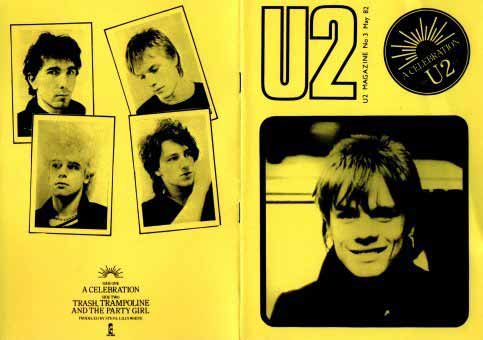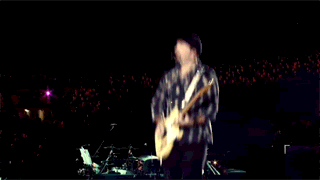|
U2 Magazine: May 1982

ON THE EDGE OF SUCCESS
by Tom Nolan
There
aren't too many players who can be said to have developed their own style on an instrument as clich-ridden as the electric
guitar, but undoubtedly one such musician is The Edge. In the five years since the band's inception, he has steadily evolved
a unique approach that owes absolutely nothing to anyone, and indeed I can't think of anybody who sounds remotely like him.
So how did he manage to come up with his own sound in the first place? Obviously there were several factors, mainly
connected with the way the band got together, as The Edge explains.
"I suppose the first link in the chain was a visit
to the local jumble sale where I purchased a guitar for a pound. That was my first instrument. It was an acoustic guitar and
me and my elder brother Dick both played it, plonking away, all very rudimentary stuff, open chords and all that. The next
stage was a note on the school board to the effect that 'Larry had wasted a lot of money on drums and was interested in finding
other people to waste money on guitars' and stuff like that, so we all in his kitchen one day. I think between us there was
one kit of drums, one bass without amp ('I had a purple Marshall amp with a tatty little speaker that used to blow up every
time I wound it up', protested Adam), one borrowed electric guitar and a borrowed amplifier. It was like first day in the
army. everyone was knocked into shape and telling everyone else what to do. It was Larry's kitchen so he was sort of in charge,
but he was only really interested in playing drums, so eventually it winnowed down from four lead guitar players to three,
then to two, then Bono started to concentrate fully on vocals, so It developed from there.
We never got into it because
we wanted to make a living. It certainly didn't enter my head at that stage. I may have been naive but I'm not that stupid.
I think maybe a year later it suddenly dawned m us that actually there wasn't such a gulf of musical ability or talent between
the stage we were at and the stage that most bands on television and with recording deals were at, so we decided then that
we would go for it.'
Gigs followed and the band began to get a following in Dublin. Eventually Bono packed his bag
and took a trip to London with his girlfriend, calling round to music papers and talking to people about U2.
'We got
a bit of interest going', recalled The Edge, and during that six month stage we were talking to yourself.'
This was
a reference to the period in September '79 when I, as an EMI A&R man, went to Dublin to see them and decided there and
then that this was the best new band around and must be signed immediately. Sadly I was alone in this opinion, and to my and
the band's intense disappointment the deal was unceremoniously booted out.
'That was a devastating period of our lives, as you
can well imagine, but we rebounded quite well, and eventually we came and did a small London tour, and off the back of that
and the subsequent Irish tour, we signed to Island Records about seven months later.'
'Much earlier on we tried to
do cover versions of things, but to be honest we were so bad at working out stuff that we just had to give it up and write
our own songs, so by the time we came to realise there were other bands doing new things it was too late, because we already
had our own style of writing. We just played together and things came out. We always try to do things differently, we never
accept the normal, so it was mainly trial and error. I like a nice ringing sound on guitar, and most of my chords I find two
strings and make them ring the same note, so it's almost like a 12-string sound. So for E I might play a B, E, E and B and
make it ring. It works very well with the Gibson Explorer. It's funny because the bass end of the Explorer was so awful that
I used to stay away from the low strings, and a lot of the chords 1 played were very trebly, on the first four, or even three
strings. I discovered that through using this one area of the fretboard I was developing a stylised way of doing something
that someone else would play in a normal way.'
Mention of the Explorer led us naturally to the subject of The Edge's
equipment, which is typically unusual. His set up is basically solid guitar into a small case of effects and from there to
two Vox AC-30's. He uses three guitars on stage these days, but when I first saw him he was using the Explorer only. I wondered
why he had chosen this particular guitar at the time.
"I think it's the most distinctive of my guitars. It seems that
the body shape affects the sound somehow. It's a very vibrant guitar with lots of treble. I had a Strat that I wasn't that
pleased with in those days, and when I was in New York with my parents, I went to some stores to look around. I picked up
this second-hand Explorer and played around on it for a while. It was just so naturally good, and it felt right, so I bought
it. It was quite cheap as well, about 450 dollars. A lot of people look at it and think it's one of the originals (under 100
of these were made in 1958, and they are very rare) but it's one of the '76 limited edition re-issue models.
"I used
it for the first album, and up until the recording of the 'October' album, but I seem to use another Strat that I bought more
and more, so 1 think I'll probably end up using the Strat for half the show and the Explorer for the rest."
"I don't
have any vintage guitars, apart from the newest addition to the collection, a lap steel, circa 1940, by Epiphone. It's art
deco, really weird. If anyone knows what a lap steel is like, it's just like a square thing, not like a guitar at all. It's
black, with inlays in some other sort of wood, also black. I got it in the States, in Nashville. I'm going to be messing about
with it a lot."
"I'm very interested in this lap steel because it's something that hasn't been done before in this
context. What we want to do is break new ground musically all the time, whether through guitars or whatever. Like you'll notice
the piano is being used a lot now. I like the textures of the piano, and I learnt to play it for the album. I think probably
the same thing will happen with the lap steel."
"I don't think a lot of people realise the musical benefit harmonics
can give to a song. I just developed that a bit and brought the harmonics more to the foreground. Some of our songs use harmonics
as the main guitar part."
|


